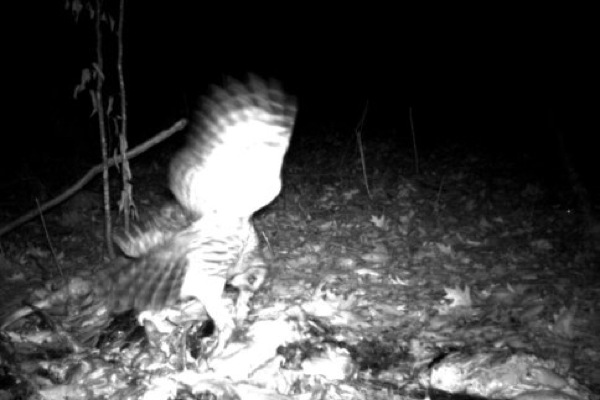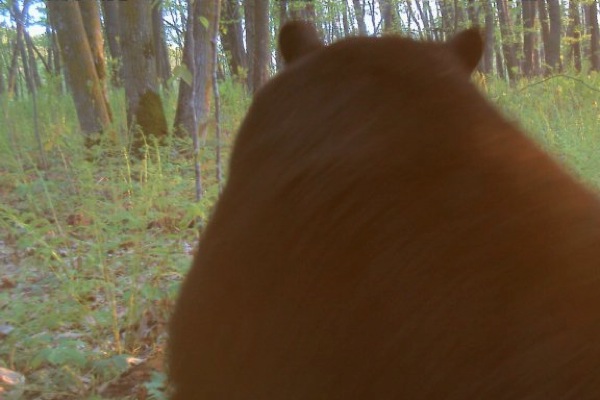LAST UPDATED: May 1st, 2015
Imagine that you have the latest high tech outdoor gear and love to be out in the woods. Now picture that trail camera sitting on a shelf in your house. Do you see something wrong with this last sentence? I hope so! I also hope your trail cameras are out in the woods right now and you are anxiously waiting to check them for your next great discovery!
You just never know who is going to show up on your camera. This Barred Owl would never have been captured if I had my camera sitting at home!
Trail Camera Fun
I highly encourage those of you with trail cameras to use them year-round and to not limit them just to the species you hunt. Using trail cameras year round not only gets you into the woods more, but the activity itself becomes a hobby of its own. I would equate it to checking a trap line. The anticipation of what you have “captured” is extremely addicting. It does come with a price, less space on your computer (I’ve had to buy an external hard drive). However, more knowledge of animal patterns, trails, and pinch points for the hunting season is the reward.
The author has captured many unique images by using his cameras year round and by placing them in unusual locations.
Trail Camera Placement
There is no limit to where, when, or how you set up your trail cameras so be creative! While many people focus only on the species they intend to hunt I would recommend that you use any “leftover” trail cameras on capturing other animals in the area; especially during the offseason. You will be surprised at the animals you will find, including deer, and what you can learn based on the photos.
Year Round Whitetail Surveillance
When using trail cameras I always try to have one in a prime whitetail area, such as a major trail or bedding location. I like to capture year round activity and try to pattern deer movement based on my photos. Besides information like directional movement and time of day, the sex ratio of the local deer population can also be collected. While food is usually the determining factor in where a deer travels, it is fun to learn how the patterns change during the pre-rut and rut as well. In fact, this info may prove the most valuable when trying to fill a buck tag.
Having cameras out after the end of the season allows you to see that these three bucks have survived!
In addition, shed hunting becomes much easier if I have an idea of when the bucks are dropping their antlers thanks to my camera. Also, in the spring, the cameras give me an idea of fawn numbers and overall deer herd health.
Mineral/Bait Locations
If you want to fill your data cards quickly with close up photos of Whitetail, try using your trail cameras by mineral or bait stations. The goal when using the mineral deposits is to support the local deer herd by supplying the does with the needed minerals to grow healthy fawns and also support maximum potential antler growth in bucks. The cameras will give you a nice method to monitor how your efforts are paying off. Just be sure to check your local state for specific laws regarding the use of minerals or bait stations.
Knowing that your mineral stations are being used is always an exciting discovery!
Gut Piles/Processing Remains/Road Kills
It may sound odd but this has been one of my favorite locations to put a trail camera. I have found a very interesting number of creatures from small to large that are enticed by the fresh smell of meat. In fact, they will return regularly to the area even after the last morsel has been devoured.
This Coyote must be checking out something above my camera, I’m guessing a bird of some kind?
I was very surprised to find a fair number of deer that came in to check out their deceased counterpart, but it pales in comparison to the number of other wildlife that are looking for a meal. I have seen everything from mice and chickadees to wolves and bears at my station. About the only thing I haven’t seen is a Cougar. I remain positive that I will get a picture of one at some point! Again, please check your local laws before hauling out butchered remains or using road-killed animals.
Other Locations For Your Trail Cameras
I have placed my trail cameras in many locations, sometimes just on a gut feeling that it could produce a unique photo opportunity. Sometimes this gut feeling pays off and at other times it is a total bust! Nevertheless, both incidences give me valuable information that I make note of. When I run multiple trail cameras I mark them with GPS coordinates and the dates to keep track of their placement. This not only ensures easy retrieval, but it will give me options in the future, if for some reason I would need to make changes to my current hunting location. There really is no limit to where you can place them!
This Black Bear is checking out the deer bones from a previous years successful hunt.
Areas of interest I would like to try, if I have the opportunity, are: large, fresh animal dens, well used fence crossings, beaver/otter slides, and upland or waterfowl nests. I have even brought a trail camera with me on vacation in the hopes I would find a potential setup location.
Saving and Organizing Your Trail Camera Images
Once you have your images, what do you do with them? Delete any pictures that were triggered from the wind, squirrels, or small birds (unless it is an interesting picture) and keep all of the larger game animals and any and all deer photos. If time permits, complete a deer survey and calculate the buck to doe ratio using your photos from a particular location.
A surprise visitor! While my goal was Pronghorn in Wyoming, this Great Blue Heron was captured multiple times strolling by my trail camera.
When saving files on a computer here is the system I use. Label each of your trail cameras C1, C2, C3, and so on. Label the digital file folders with that same coding: C1, C2, C3, etc. Within those folders, create folders with the following information: camera number, the date range of the specific photos, and the GPS coordinates of the specific location. The individual photo series folders looks like this: C1 (camera number), 3-1–4-26-14 (date range, March 1st through April 26th, 2014), 45.89379, -93.571179 (GPS coordinates).
Keeping your trail cameras out year-round is no doubt beneficial. It allows you to fully utilize your trail cameras advantages by keeping you active and in touch with what is going on in your hunting areas. It also increases your awareness of what is lurking around your hunting spots. And, who knows, you may be the first person to really capture photographic evidence of Bigfoot!













